Dahlias are subtropical flowers native to Central America. But many North American gardeners grow this plant, coveting its ornate blooms. The secret to successfully growing dahlias in cooler climates lies underground in their tubers. Dahlia tubers are not true bulbs, as they differ in appearance and growth. Bulbs are round and consist of one swollen root while tubers come in various shapes and form in a cluster. Also, bulbs grow from one fixed point, whereas tubers (such as potatoes) grow out of the "eyes." Because dahlias only thrive as far north as USDA plant hardiness zone 9, cold-climate gardeners must learn to work with these finicky tubers by digging them up and storing them each year.
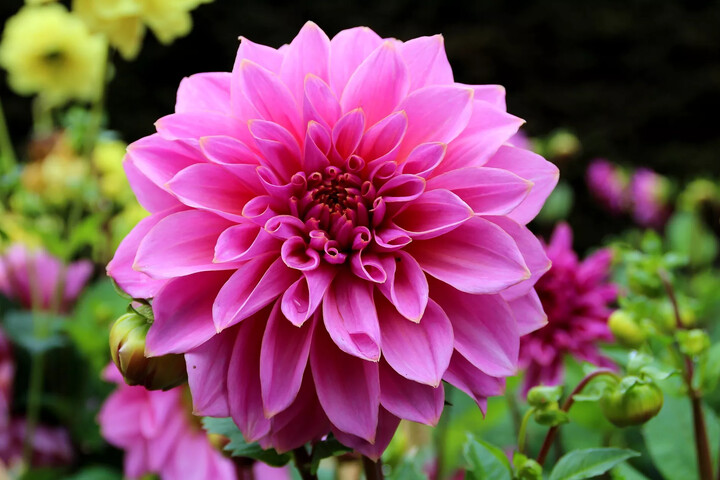
When to Dig Up Dahlia Tubers
Mother Nature will alert you when it's time to dig up your dahlia tubers. When the first light frost of autumn arrives, the dahlia leaves will turn brown. At this point, only the aboveground vegetation has perished. Deep underground, the dahlia's tubers are still alive and waiting for you to uproot and store them until warmer weather returns.1
Don't be hasty about digging before the first frost. Frost stimulates dahlia tubers to set eyes for next year. So hold off about a week or two after the first frost, but make sure to pluck them well before any hard freeze to prevent damage.
What You'll Need
Equipment / Tools
Garden fork or spade shovel
Gardening gloves
5-gallon bucket
Hand pruners
Long-sleeve shirt and pants
Dust mask
Spray bottle
Materials
Soil sulfur dust
Sphagnum peat moss
Mesh bags
Cardboard box
Instructions
Digging, Trimming, and Washing the Tubers
You can dig up dahlia tubers with a garden fork or standard shovel. Be careful not to let the tool come in contact with the tuberous roots, which are easily damaged.
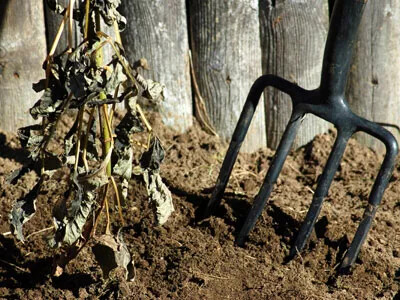
Loosen Soil
Loosen the soil around the dahlia tubers by thrusting the fork or shovel into the ground about a foot away from the plant. Gingerly pry up the soil as you go, freeing the tubers.
Remove Mound
With one hand on the stem and the other under the clump of tubers, carefully remove the entire mound from the ground.
Knock off Dirt
Poke the edges of the clump gently to knock off most of the dirt.
Prune Vegetation
Prune off almost all of the aboveground vegetation, leaving just a little bit.
Wash Dirt off Tubers
Wash the dirt off your dahlia tubers by swishing them around in a bucket of water or hosing them down with a garden hose. Be very gentle. Even the slightest puncture can introduce pathogens, causing your tubers to rot in storage.
Applying Sulfur Dust to the Tubers
To prevent rot and deter fungus, many gardeners opt to sprinkle sulfur dust onto tubers before storage.1 Come spring, you can plant them, dust and all, to continue to thwart decay before they sprout.
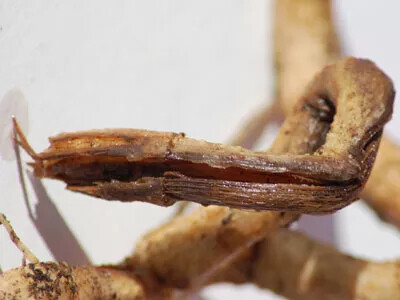
Inspect Tubers
Inspect your dahlia tubers, and trim away any parts that are rotten. Also, remove the "mother" tuber. In the case of first-year plants, this will be the original tuber that you bought and planted. This old tuber is more likely to rot than the new ones, and such rotting could spread to the others in storage.
Let Tubers Sit
Let the tubers sit for a day or so to allow the cuts to callous over.
Prepare for Sulfur
Protect yourself from the sulfur dust by wearing long pants, a long-sleeve shirt, a dust mask, and gloves.
Sprinkle Sulfur on Tubers
Sprinkle the tubers liberally with sulfur dust. Take care to apply the powder to any areas that are nicked or cut.
Dividing and Drying the Tubers
You might want to divide the tubers before you dry them for storage, rather than waiting until spring. However, sometimes the "eyes," which are crucial for reproduction, don't appear until after the winter storage period. In this case, it can be more time-efficient to wait until spring to divide them.
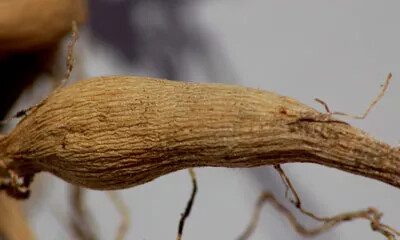
Divide Tubers
Divide the tubers like you would remove garlic cloves from a bulb. Take care to preserve at least one eye per tuber.
Hang Tubers
Hang the tubers upside down with twine. Or place them in a mesh bag, and allow them to cure outdoors for two weeks. Only use the latter method if temperatures are above freezing. If rain is forecasted, move the tubers indoors to a location that does not receive direct sunlight.
Cut Remaining Stems
Once the dahlia tubers are dry, cut off the remaining stems with pruners.
Preparing the Medium and Storing the Tubers
Some gardeners prefer storage mediums, such as vermiculite, coarse sand, sawdust, or wood shavings. But for this particular method, sphagnum peat moss works great.
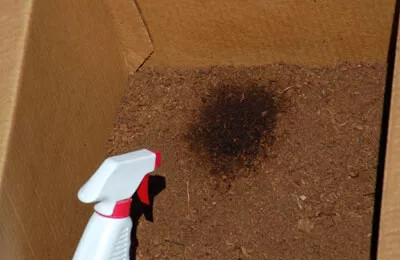
Line Cardboard Box With Newspaper
Line the bottom of a cardboard box with newspaper to cover any cracks. Pour in 2 inches of peat moss.
Moisten Peat Moss
Moisten the peat moss slightly using a spray bottle. Make sure not to saturate it, which will encourage rot. Instead, strike a balance between dry and wet, erring on the side of dry.
Lay Tubers
Lay the tubers onto the medium, and then cover them with an additional inch of peat moss. If you divided the tubers, make sure they are not touching one another.
Store Box in Dark Area
Store the box in a dark area—such as a basement or root cellar—that will remain cool for the winter but will not freeze. The ideal storage temperature is above freezing but below 50 degrees Fahrenheit.
Check Tubers
Periodically check your tubers during the winter. If they seem overly dry, spritz the peat moss with a spray bottle. And if a tuber feels mushy, discard the rotten culprit before it infects the lot.
Plant Tubers
Plant your tubers in the spring, just after the danger of the last frost has passed. If you're not sure when that is, ask an experienced gardener at your local garden center or check with your county's extension office. In some North American zones, you can use Memorial Day as a cue to plant most tubers.
Tips for Overwintering Dahlia Tubers
Experiment with your storage method until you find a system that works best for your plants. This might mean wrapping your dahlia tubers in newspaper to soak up excess moisture before storing them in the box filled with peat moss or opting to store them in paper bags instead of a box.
Alternatively, you can add peat moss to a zippered bag, place the dried tubers into the bag, add a liberal sprinkling of sulfur dust, seal the bag, and then gently shake it to distribute the dust. Then, the tubers are ready to be stored in your box filled with peat moss.
Label the dahlia tubers if you have different types, so you know which cultivars you're working with when spring rolls around. And consider using separate boxes for storage.